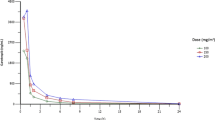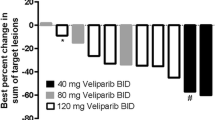Abstract
Background/purpose: 4-Ipomeanol (IPO; NSC394438), anaturally occurring furan isolated from common sweet potatoes(Ipomoea batatas) infected with the fungus Fusariumsolani was the first agent to be developed by theNationalCancer Institute based on a biochemical-biological rationaleas an anticancer agent targeted specifically against lungcancer. Prior to clinical development, IPO was shown to inducepulmonary toxicity in the lungs of several mammalian speciesbecause the agent is metabolized to a highly reactive furanepoxide by specific cytochrome P450 monooxygenases found inpulmonary Clara cells and type II pneumocytes, which sharebiochemical features with bronchogenic carcinoma. However,instead of inducing the anticipated lung toxicity in patientswith lung cancer in disease-directed phase I studies,hepatotoxicity was the principal toxic effect of IPO inhumans. Based on the presumption that IPO may bepreferentially activated by cytochrome P450 monooxygenases inliver cells and biochemically-related hepatic malignancies, aphase II study was conducted to determine the activity andevaluate the toxicity of IPO in patients with advancedhepatocellular carcinoma.Patients and methods: Nineteen patients with advancedmeasurable hepatocellular carcinoma were enrolled on the phaseII trial. All patients had an Eastern Cooperative OncologyGroup performance status of at least two, no evidence ofpulmonary dysfunction, and had either no prior treatment orminimal prior therapy. Patients were treated with IPO at adose of either 1032 mg/m2, which was the maximumtolerated and recommended phase II dose previously derived forpatients with normal hepatic function (15 patients) or 826mg/m2 if they had serum bilirubin concentrations intherange of 2.0 to 3.0 mg/dL (four patients). Treatment wasrepeated every three weeks. Objective tumor response, theprimary endpoint of the study, was assessed after every twocourses of treatment, and both pulmonary function and lungdensity were rigorously monitored using successive pulmonaryfunction testing and computerized tomography.Results: All nineteen patients were evaluable forbothresponse and toxicity. No major objective responses wereobserved. One patient had a minor, brief reduction in lungmetastases. Although marker lesions and overall diseaseremained stable for at least 12 and 24 months in three and twopatients, respectively, the median time to progression wasthree months and the median survival was five months for allpatients. The principal toxicity was reversible elevations inhepatic transaminases, which occasionally resulted in dosereduction. No clinically-significant pulmonary toxicity wasnoted.Conclusion: IPO at a dose of either 826 or 1032mg/m2 administered every three weeks did notdemonstratea relevant degree of clinical activity against advancedhepatocellular carcinoma. Further evaluations of TO is notrecommended for this disease.
Similar content being viewed by others
References
Boyd MR, Burka LT et al: Lung toxic furanoterpenoids produced by sweet potatoes) Ipomea batatas following microbial infection. Biochem Biophys Acta 337: 184–195, 1974
Boyd MR, Wilson BJ: Isolation and characteristic of 4–Ipomeanol, a lung toxic furanoterpenoid produced by sweet potatoes (Ipomeoea batatas). J Agr Food Chem 20: 428–20, 1972
Boyd MR, Wilson BJ, Harris TM: Confirmation by chemical synthesis of the structure of 4–Ipomeanol, a lung-toxic metabolite of the sweet potato, Ipomoea batatas. Nature New Biol 236: 158–159, 1972
Boyd MR: Evidence for the Clara cells as a site of cytochrome P450 dependent mixed function oxidase activity in lung. Nature (Land) 269: 713–715, 1977
Christian MC, Writes RE, Leyland-Jones Be et al: 4–Ipomeanol: a novel investigational new drug for lung cancer. J Natl Cancer Institute 81: 1133–1143, 1989
Boyd MR: Biochemical mechanisms of chemical-induced lung injury: roles of metabolic activation. CRC Crit Rev Toxicol 7: 103–176, 1980
Boyd MR, Reznik-Schuller Hill: Metabolic basis for the pulmonary clam cells as a target for pulmonary carcinogenesis. Toxicol Rather 12: 56–61, 1984
Boyd MR: Role of metabolic activation in the pathogenesis of chemically induced pulmonary disease: mechanism of action of the lung toxic furan, 4–Ipomeanol. Environ Health Perspect 16: 127–138, 1976
Boyd MR: Metabolic activation and lung toxicity: a basis for selective cell pulmonary damage by foreign chemicals. Environ Health Perspect 55: 47–51, 1984
Boyd MR, Grygiel, JG, Minchin, RE: Metabolic activation as a basis for organ-selective toxicity. Clin Exp Pharmacol Physiol 10: 87–107, 1983
Boyd MR, Burka LT, Wilson BE: Distribution, excretion and binding of radioactivity in the rat after intraperitoneal administration of the lung-toxic fur [14C] 4–Ipomeanol. Toxicol Apgar Pharmacol 32: 147–157, 1975
Boyd MR, Burka LT: In vivo studies on the relationship between target organ alkylation and the pulmonary toxicity of a chemically reactive metabolite of 4–Ipomeanol. J Pharmacol Exp Them 207: 677–686, 1978
Boyd MR, Burka LT, Wilson BE, Sam HA: In vitro studies on the metabolic activation of the pulmonary toxin 4–Ipomeanol by rat lung and liver microsomes. J Pharmacol Exp Ther 207: 677–686, 1978
Ravindranath V, Burka I, Boyd MR: Reactive metabolites from the bioactivation of toxic methylfurans. Science 224: 884–886, 1984
Shoemaker R, Monks A, Alley M, et al: Development of human tumor cell line panels for use in diseaseoriented drug screening. Pros Class Biol Res 276: 265–286, 1988
Dutcher JS, Boyd MR: Species and strain differences in targetorgan alkylation and toxicitics by 4–Ipomeanol. Predictive value of covalent binding in studies of target organ toxicities by reactive metabolites. Beacham Pharmacol 28: 3367–3372, 1979
Boyd MR, Sam HA, Franklin RB: Comparison of ratios of covalent binding to total metabolism of the pulmonary toxin, 4–Ipomeanol, in vitro in pulmonary and hepatic microsomes and the effects of pretreatment with Phenobarbital or 3–methylchlorantrene. Beacham Biophys Res Common 193: 1167–1172, 1980
Devereux. AMR, Jones KG, Bend JR, et al: In vitro metabolic activation of the pulmonary toxin, 4–Ipomeanol in nonciliated bronchiolar epithelial (Clara) and alveolar type II cells isolated from the rabbit lung. J Pharmacol Exp Ther 220: 223–227, 1982
Parandoosh Z, Fujita VMS, Coon NJ, et al: Cytochrome P-450 isoenzymes 2 and 5 in rabbit lung and liver. Drug Moab Drapes 15: 59–67, 1987
Slaughter SR, Statham CN, Philpot RM, Boyd MR: Covalent binding of metabolites of 4–Ipomeanol to rabbit pulmonary and hepatic proteins and the enzymes of the pulmonary cytochrome P-450 dependent monooxygenase system. J Pharmacol Exp Ther 224: 252–257, 1983
Boyd MR: Effects of inducers and inhibitors on drug metabolizing enzymes and drug toxicity in extrahepatic tissues. Ciba Found Symp 76: 43–66, 1980
Wolf CR, Statham CN, McMenamin MG, et al: The relationship between the catalytic activities of the Lungspecific toxicity of the furan derivative, 4–Ipomeanol. Mol Pharmacol 22: 738–744, 1982
Sasame HA, Gillette JR, Boyd MR: Effects of anti-NADPHcytochrome c reductase and anti-cytoplasmic b5 antibodies in the hepatic and pulmonary microsomal metabolism and covalent binding of the pulmonary toxin 4–Ipomeanol. Biochem Biophys Res Commun 84: 389–395, 1978
Boyd MR, Dutcher JS: Renal toxicity due to reactive metabolites formed in situ in the kidney: investigations with 4–Ipomeanol in the mouse. J Pharmacol Exp Ther 216: 640–647, 1981
Buckpitt AR, Statham CN, Boyd MR: in vivo studies on the target tissue metabolism, covalent binding, glutathione depletion, and toxicity of 4–Ipomeanol in birds, species deficient in pulmonary enzymes for metabolic activation. Toxicol Appl Pharmacol 65: 38–52, 1982
Buckpitt, AR, Boyd MR: Metabolic activation of 4–Ipomeanol by avian tissue microsomes. Toxicol Appl Pharmacol 65: 53–62, 1982
Durham SK, Boyd MR, Castleman WL: Pulmonary endothelial and bronchiolar epithelial lesions induced by 4–Ipomeanol in mice. Am J Pathol 118: 66–75, 1985
Smith AC, Barret D, Stedham MA, et al: Preclinical toxicology studies of 4–Ipomeanol: a novel candidate for clinical evaluation in lung cancer. Cancer Treat Rep 71: 1157–1164, 1984
Clinical Brochure. 4–Ipomeanol NSC 349438. Bethesda, MD: Division of Cancer Treatment, National Cancer Institute, February 1988
Boyd MR, Burka L, Wilson B, Rama B: Development of tolerance to the pulmonary toxin, 4–Ipomeanol. Toxicology 19: 85–100, 1981
Falzon M, McMahon JB, Schuller HM, Boyd MR: Metabolic activation and cytotoxicity of 4–Ipomeanol in human nonsmall cell lung cancer cell lines. Cancer Res 46: 3483–3489, 1986
McLemore TL, Liu MC, Blacker PC, et al: Novel intrapulmonary model for orthotopic propagation of human lung cancers in athymic mice. Cancer Res 47: 5132–5140, 1987
McLemore T, Coudert B, Adelberg S, Boyd MR, et al: Metabolic activation of 4–Ipomeanol by human pulmonary carcinoma cells propagated in vitro and intrabronchially in nude mice. Clin Res 36: 498A, 1988
McLemore TL, Litterest CC, Coudert BP, et al: metabolic activation of of 4–Ipomcanol in human lung, primary pulmonary carcinomas, and established human pulmonary carcinoma cell lines. J Natl Cancer Inst 82: 1420–1426, 1990
Rowinsky E, Noe D, Ettingcr D, et al: Phase I and pharmacological study of the pulmonary cylotoxin 4–Ipomeanol on a single dose schedule in lung cancer patients: hepatotoxicity is dose limiting in humans. Cancer Res 53: 1794–1801, 1993
Kasturi VK, Dearing MP, Piscitelli SC, et al: Phase I study of a five-day Dose Schedule of 4–Ipomeanol in patients with non-small cell lung cancer. Clin Cancer Res 4: 2095–2102, 1998
Boyd MR, Stiko AS, Statham CN, Jones RB: Protective role of endogenous pulmonary glutathione and other sulfhydryl compounds against lung damage by alkylating agents. Investigations with 4–Ipomeanol in the rat. Biochem Pharmacol 31: 1579–1583, 1982
Buckpitt AR, Boyd MR: The in vitro formation of glutathione conjugates with the microsomally activated pulmonary bronchiolar alkylating agent and cytotoxin, 4–Ipomeanol. J Pharmacol Exp Ther 215: 97–103, 1980
Cook JA, Pass HI, lype SN, et al: Cellular glutathione and thiol measurements from surgically resected human lung tumor and normal lung tissue. Cancer Res 51: 4287–4294, 1991
Calvert P, Yao KS, Hamilton TC, O'Dwyer PJ: Clinical studies of revcrsal of drug resistance based on glutathione. Chem Biol Interact 24: 213–224, 1998
O'Dwyer PJ, Hamilton TC, LaCreta FP, et al: Phase I trial of buthionine sulfoximine in combination with melphalan in patients with cancer. J Clin Oncol 14: 249–256
Dexter DL, Calabresi P: Intraneoplastic diversity. Biochim Biophys Acta 695: 97–112
Park JG, Lee SK, Hong IG, et al: MDR-1 gene expression, its effect on drug resistance to doxorubicin in human hepatocellular carcinoma cell lines. J Natl Cancer Inst 86: 700–705, 1994 Address for offprints: Eric K. Rowinsky, M.D. Institute for Drug Development, Cancer Therapy and Research Center, 8122 Datapoint Drive, Suite 700, San Antonio, TX 78229–3272, USA; Tel.: 210–616–5945, e-mail: erowinsk@saci.org
Author information
Authors and Affiliations
Rights and permissions
About this article
Cite this article
Lakhanpal, S., Donehower, R.C. & Rowinsky, E.K. Phase II Study of 4-Ipomeanol, a Naturally Occurring Alkylating Furan, in Patients with Advanced Hepatocellular Carcinoma. Invest New Drugs 19, 69–76 (2001). https://doi.org/10.1023/A:1006408803734
Issue Date:
DOI: https://doi.org/10.1023/A:1006408803734




